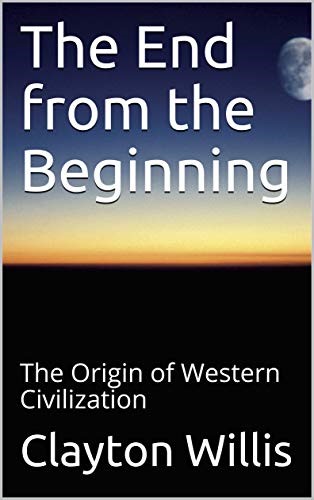How The Israelites (not Jews) Spread the Gospel of Jesus
This post encapsulates the most startling discovery I made during the research for my book. I’m still amazed by the change in my perspective since that discovery.
Quoted (with some updates added) from Chapter 10, pages 254-256 The End from the Beginning (The Origin of Western Civilization) https://www.amazon.com/dp/1718091494?ref_=pe_870760_150889320:
What should be of considerable interest to Christians today is tracing the work of the hand of God in preparing the Israelites to spread the Gospel of Jesus Christ. This information, so far as we’ve been able to determine, is a new concept of how the church that Jesus established was able to grow from the 12 apostles and a few thousand converts in the first century AD to nearly 40 million Christians in the next 275 years.
Most Christians, it seems, are under the impression that the 12 apostles, the apostle Paul and the relatively few Jewish believers were somehow able to convert enough “gentiles” to carry the gospel to the rest of Europe after the death of the apostles – most of whom had died or were martyred by the time Jerusalem and the temple was destroyed in 70 AD.
By recognizing that the hand of God was still at work with Israel we found not only Biblical clues but secular historical clues as to what really happened. Our magnificent God who “knows the end from the beginning”, had sequestered a large number of Israelites in the Parthian Empire in the 1st Century AD.
See this related post: The “Blind Spot” in History
The first and what should have been the most obvious clue to that fact is a statement by the Jewish historian Josephus who in 94 AD stated that the 10 tribes were still located “beyond the Euphrates” in numbers too large to count and that only the two tribes (Judah and Benjamin) were under the rule of the Roman Empire. A few historians quibble with various parts of Josephus’ writing but virtually none question his statements about his personal time period.
Josephus, in 94 AD (~60 years after Jesus’ death) proclaims the location of the 10 tribes of Israelites, indicates they were known to be Israelites (not “Jews”) and that there were a great many of them.
When we read in Matthew’s Gospel that Jesus sent His apostles to “the lost sheep of the House of Israel” [Footnote: Matthew 10:5–23], most Christians assume that He meant the Jews scattered abroad among the gentiles in the Roman Empire. We read and marvel – and rightly so – at the missionary journeys of Paul, the “apostle to the Gentiles” [Footnote: Romans 11:13; Galatians 2:8], and all his persecutions, many trials and tribulations.
However, if you count the cities in which Paul helped establish congregations, and generously allow for perhaps 300 to 500 conversions in each of the 14 locations described in Acts, add some number of Christians to account for the Jews who converted to Christianity and round the total number to 30 congregations, there were perhaps as many as 20,000 Christians in the Roman Empire in 70 AD.
From End Note: Some scholars count fourteen or more, directly or indirectly. We know he planted the church at Ephesus, which in turn branched out to plant many others. There were also organic churches in Phillipi and Corinth. Then three churches were planted in Cypress and Crete. There’s also Thyatira, Philadelphia, Smyrna, Laodicea, Pergamon, Syria, Arabia, Sardis. Some count up to twenty churches planted by Paul either directly or indirectly. https://www.quora.com/profile/Marie-ODay
It’s not an insignificant number but with all the persecution Christians faced in the Roman Empire – described in the Bible and in secular history – it does not explain the exponential growth of the church to 35 million by 400 AD. Footnote: The Rise of Christianity Rodney Stark (Princeton, NJ: Princeton University Press, 1996)
We learned from many historical sources (including Eusebius and other “church fathers”) and the magnificent research of William Steuart McBirnie that there were at least five of the original apostles – holy spirit-filled, eye-witnesses of the life, death, burial and resurrection of Jesus of Nazareth – who spent from 10 to 30 years in the Parthian Empire establishing congregations and preaching the Gospel. Footnote: William Steuart McBirnie, PhD The Search For the 12 Apostles ©1973 Tyndale House Publishers, Carol Stream, IL 60188
The apostle Peter, whose first epistle was written from Babylon – a province of the Parthian Empire – was joined by Thomas, Thaddeus, Bartholomew and Simon Zelotes and perhaps others. The New Testament narrative does not mention these apostles (other than Peter) after the 1st chapter of the book of Acts.
Have you noticed that fact and how would you explain that 8 of Jesus’ 12
ambassadors to the world are not mentioned elsewhere in the New Testament
canon? Did those eight fail to follow Jesus’ instruction?
Secular and Biblical historians ignore or at least seem unaware that it’s highly likely that 500,000 to 1,500,000 Israelites were located in the Parthian Empire in the first century AD, many of whom – just as predicted by the Old Testament prophets – returned to the worship of the one Creator God of their ancestors.
End Note: 1 When all these blessings and curses I have set before you come upon you and you take them to heart wherever the Lord your God disperses you among the nations, 2 and when you and your children return to the Lord your God and obey him with all your heart and with all your soul according to everything I command you today, 3 then the Lord your God will restore your fortunes and have compassion on you and gather you again from all the nations where he scattered you. Deuteronomy 30:1-3
Secular history confirms the conversion to Christianity of many of the people of the Parthian Empire though “Israelites” are not mentioned. Biblical historians (see Rawlinson’s confirmation below) also note the conversion but their “blind spot” keeps them from recognizing the power and majesty of the hand of God at work — His having planned for the rapid growth of His church and His reconciliation of the House of Jacob.
The Israelites already carried with them the ancestral knowledge of the “law of
Moses” and the Ten Commandments though for centuries many of them had been
worshiping the false Gods of the nations into which they were dispersed in 721
BC.
Were they perfect in their Christian belief? Are there any “perfect” Christians today?
Some of them were present on the day of Pentecost about 50 days after Jesus
ascended back to God, the Father. It was that day when God poured
out His spirit upon the apostles and they began performing the task to which
they had been appointed by Jesus. Footnote: Acts chapter 2
Read for yourself of the “Parthians, Medes, residents of Mesopotamia and Asia” – all parts of the Parthian Empire – who were present for the proclamations of Peter and the other apostles on that day.
Secular history confirms, as does McBirnie, the conversion of many in the Parthian Empire with one province of that Empire – Armenia – declaring Christianity as the official religion of that province in 301 AD, long before Emperor Constantine declared Christianity the official religion of the Roman Empire.
(See George Rawlinson’s comments below on other evidence of Christianity in the Parthian Empire.)
As a result of the efforts of the apostles there may have been several million Christians in the Parthian Empire by the middle of the 2nd Century AD. There was little if any persecution of Christians in the Parthian Empire, which had free trade with the Roman Empire as well as many of the nations of eastern Europe.
Though George Rawlinson (23 November 1812 – 6 October 1902) is perhaps the premier historian of the ancient empires of the Middle East, this Bible scholar never notes the Israelites (not Jews) who were located in the Parthian Empire but refers to all of them as “Jews”.
See this related post: The “Blind Spot” in History
Quote from George Rawlinson The History of Parthian Empire:
Christianity also penetrated the Parthian provinces to a considerable extent, and in one Parthian country, at any rate, seems to have become the state religion. The kings of Osrhoene are thought to have been Christians from the time of the Antonines, if not from that of our Lord; and a nourishing church was certainly established at Edessa before the end of the second century.
The Parthian Jews who were witnesses of the miraculous events which signalized the day of Pentecost may have, in some cases, taken with them the new religion to the land where they had their residence; or the Apostle, St. Thomas, may (as Eusebius declares) have carried the Gospel into the regions beyond the Euphrates, and have planted the Christian Church in the countries out of which the Jewish Church sprang.
Besides the nourishing community of Edessa, which was predominantly, if not wholly, Christian from the middle of the second century, many converts were, we are told, to be found among the inhabitants of Persia, Media, Parthia Proper, and even Bactria.
From Encyclopedia Britannica:
Osroëne, also spelled Osrhoene, ancient kingdom in northwestern Mesopotamia, located between the Euphrates and Tigris rivers and lying across the modern frontier of Turkey and Syria. Its capital was Edessa (modern Urfa, Turkey).
The Parthian province of Armenia declared Christianity the state religion just after 300 A.D.
When the Roman General Severus took Ctesiphon, the capitol city of the Parthian Empire in 197 A.D., the Roman Army killed almost all of the men but took 100,000 women and children and removed them back into the Roman Empire. At that point in time, something more than 50% (the percentage may have been a lot higher) of the population was Christian. In this one incident, though they were enslaved, there were then at least 40,000 Christians introduced into the Roman Empire.

